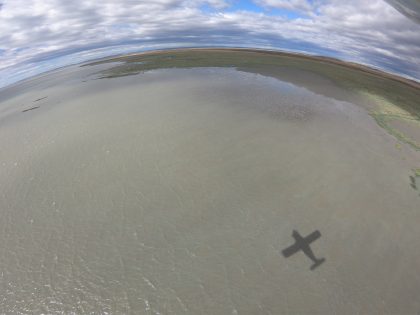
During our recent research trip to Tierra del Fuego, I had the chance to participate in aerial shorebird counts along the shores of Bahia Lomas.
I joined Guy Morrison and the pilot, Alejandro Cornejo, in order to control a GoPro camera that we mounted under the wing. The idea was to take a shot whenever we encountered shorebirds so that we could later match habitat attributes to shorebird locations.
Guy has been flying this coastline in small planes counting shorebirds since 1982, and has not missed a year since 2000.
Usually aerial counts are only flown at high tide, when the birds are concentrated at roost sites and much easier to count. But this year we conducted supplemental flights at different tide stages in order to characterize shorebird habitat use when they were feeding.
The counts this year showed overall that the red knot population in Bahia Lomas is nearly the lowest ever recorded.
The 2018 tally is 25% lower than the 2017 count. This population drop is likely attributable to the tough year the birds had in the Delaware Bay in the previous spring, when during much of the shorebird stopover in May, horseshoe crab spawning was stalled due to low water temperatures.
Fourteen years ago, research published by Alan Baker demonstrated that a rapid decline (from 51,000 to 27,000) in the red knot population of Tierra del Fuego was due to a lack of horseshoe crab egg availability in Delaware Bay. The population at Bahia Lomas has never recovered, now ranging between 10-14,000 birds.
The link between eggs and the fate of red knots was emphasized again in research published last year in the Proceedings of the Royal Society B. This work showed that individual red knots leaving the Delaware Bay in poor condition are less likely to breed in the Arctic and are furthermore less likely to survive.
And a lot of red knots left the bay last year in poor condition.
The previous decline in the red knot population of Bahia Lomas was due to the overharvest of horseshoe crabs. Those circumstance led to a long string of bad years in the Delaware Bay for red knots because there simply weren’t enough horseshoe crabs to meet the caloric demands of the shorebird population.
Under current circumstances, we have a stable crab population so “good” and “bad” years are largely a product of weather conditions and tide timing. This means that next year could easily be a good one.
In 2018, we hope for favorable weather and water temperatures while conservation programs continue that ensure that red knots and other shorebirds have unfettered access to high quality feeding habitat. This includes restoring beaches to make better horseshoe crab spawning habitat and enforcing regulations that minimizes human disturbance of the shorebirds in their Delaware Bay feeding areas.
Careful management of horseshoe crab populations is also necessary to ensure that harvest and their use in lysate production does not jeopardize the population and instead allows a recovery of the population to their former levels.
Aerial counts and other forms of monitoring will continue to take the pulse of the population in Bahia Lomas, Delaware Bay and elsewhere. This work is essential for identifying the range of factors, both positive and negative that influence the population over time.